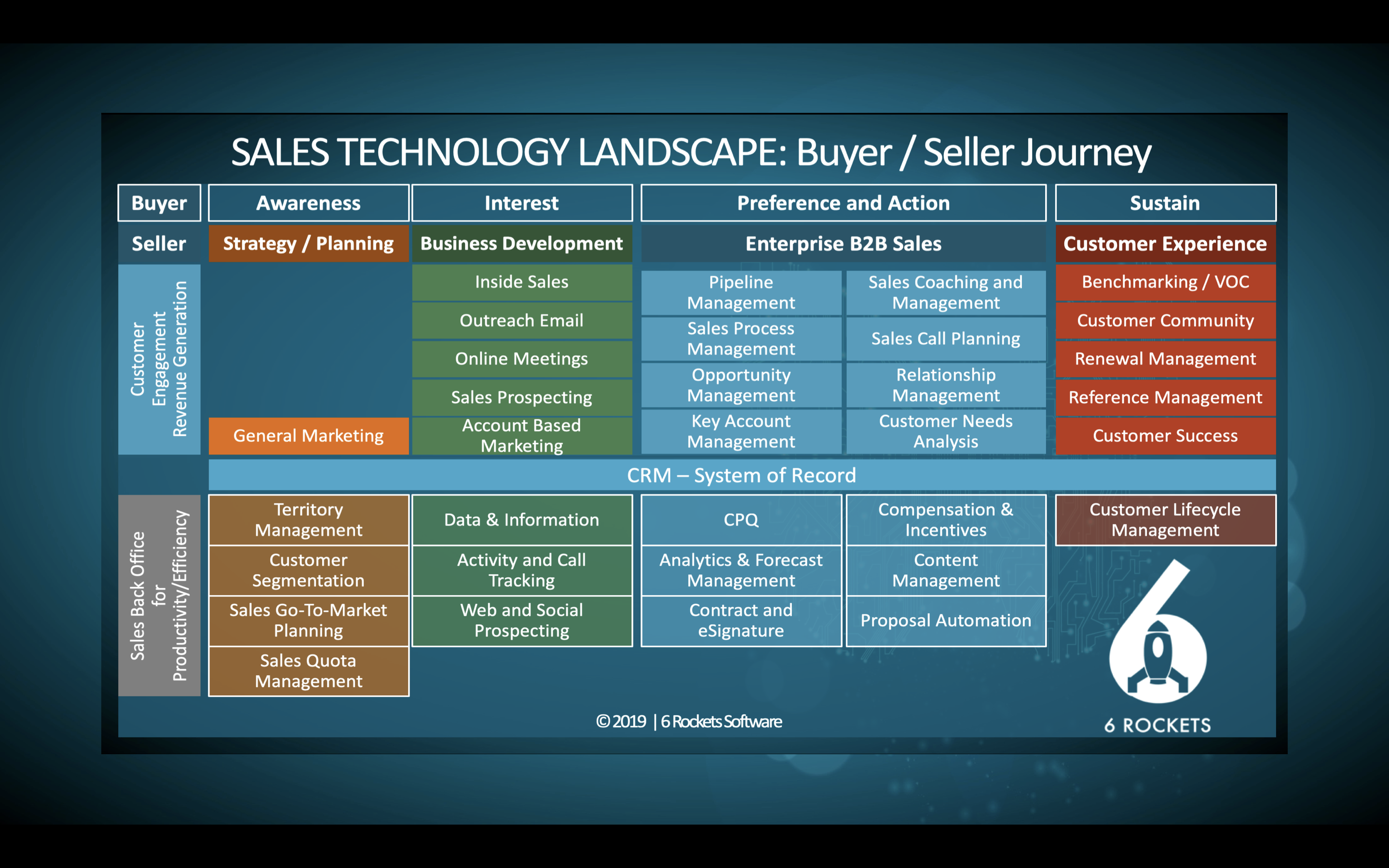Sales leaders are all the time looking for new technologies to gain an advantage for their team. But when you’re trying to choose or prioritize, there are so many options.
According to Nancy Nardin or Nicolas de Kouchkovsky who have both researched the market to compile and categorize all available products, there are close to 1,000 different sales tools! (See Nancy Nardin’s Sales Technology Landscape, 2018 Sales Technology Landscape – from Nicolas)
It can all be a little overwhelming.
Where do you start?
I’ve thought about it like this:

- Think about the buyer journey
- Map that to the five phases in the Sales, Marketing and Customer Service continuum: Awareness, Interest, Preference, Action, Sustain.
- Then think about the two orientations: Front and Back office (above and below the CRM line in my graphic).
- When you combine the five phases and the two orientations, you now have identified the 10 segments that might form part of your Sales Tool Capability Plan. This is what you have to choose from or prioritize.
- What problem are you really trying to solve? Where are the capability gaps in the sales team? Are there inefficiencies you can remove?
- You need to select between Effectiveness or Efficiency. These typically (but not always) map to Front and Back office, and then focus on the phases of the buyer journey where you think you might need technology to help you move the needle for/with your sales team.
- Then you can build your Sales Tools Capability plan across the ten segments to add capabilities to align with that prioritization.
- Now you can start looking at suppliers.
At a recent presentation I gave for Harvard Business Review I was asked to include an overview of the Sales Tech Landscape. Here is a 3 minute video extract of that portion of my presentation.
Video Transcript (autogenerated by Youtube)
One of the things I wanted to spend just a couple of minutes on is …
Some thoughts around technology across the whole sales tech landscape.
The whole buyer-seller journey.
The first thing the buyer does is they become AWARE of what you have
Then, hopefully, they have some INTEREST.
As you speak to them, they develop PREFERENCE, and take some ACTION.
After that they want to SUSTAIN the relationship with you.
Your marketing team is typically involved early, building awareness,
Making sure the buyer knows you exist. As you continue, as you step forward the key relationship gets handed off to sales – as you’re moving through the INTEREST layer
Now you’ve got a qualified opportunity and an account that fits.
Salespeople take that on.
The other team increasingly involved in the revenue team over the last few years is your customer success people. These are the people who are charged with making sure that the customer is successful with your business.
That’s the buyer journey and how your marketing, sales, and customer success teams might choose to engage. We want that continuum. We don’t want it to drop off along the way. And when we’re selling we think about the sellers activity that balances that.
On the left, at the top, I’ve got customer engagement – how I am building revenue.
What are the capabilities that your organization should bring?
You’re going to have your CRM. It’s going to be your system of record.
Then, general marketing and territory management.
Things that go on in the strategy area.
In the business development area you have things like inside sales, outreach, online meetings, sales prospecting, those kind of things
Then in enterprise b2b sales, what my sales team is doing:
pipeline management, sales process, opportunity management and so on.
At the back end they’re also doing things like CPQ, analytics, forecast management, e-signatures, compensation.
So I’m trying to give you a picture of the overall structure.
The point is: There is a breadth of capability. I tried to break that down into ‘where we care’ in the different lanes
If you want to read more of my blogs please subscribe to Think for a Living blog. Follow me on Twitter or connect on LinkedIn. I want you to agree or disagree with me, but most of all: I want you to bring passion to the conversation.
Donal Daly founded Altify in 2005, served as CEO for 11 years and Executive Chairman for two years, before taking us his current role as a Non-Executive Director. He is now Chief Rocket Launcher at 6 Rockets Software, his sixth and most recent global business enterprise. venture. Donal is author of numerous books and ebooks including the latest Amazon #1 Bestseller Digital Sales Transformation in a Customer First World (Nov 3, 2017) and his previous Amazon #1 Best-sellers Account Planning in Salesforce and Tomorrow | Today: How AI Impacts How We Work, Live, and Think.

